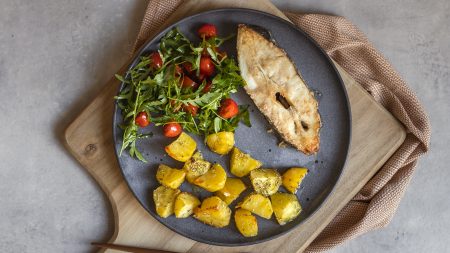
Skip the Ice Cream & Take Your Child to the Farmer’s Market :)
All mothers want the best for their children and wonder what they can give them besides love and security. I have an idea! How about health?
As a mum, I attach great importance to the nutrition of my children. A balanced diet is the first step on the way to health. Apparently, all moms seem to know this, but I have recently come across some scary statistics that inspired me to write this post.
According to the World Health Organization, nearly 40 million children under the age of five worldwide are overweight. Among children aged 5 to 19, the rates are much higher. It is estimated that over 340 million are overweight.
Unfortunately, in Poland the statistics do not look better. About 10% of children between the ages of 1 and 3 are overweight/obese, and over 18% are at risk of being overweight. The problem of excess weight and obesity also affect almost every third 8-year-old. On the other hand, among children and adolescents aged 10-16, according to the research of the Food and Nutrition Institute, as many as 22% are overweight or obese. This means that the number of children affected by this problem has doubled in the last 50 years. This is due to the lack of physical activity and the consumption of high-calorie products.

Dear Moms, There’s No Time to Lose, the Health of Your Children Depends on You!
Have you ever wondered how many unhealthy snacks you serve your child during the day? Sometimes I hear that children eat a chocolate bar for breakfast and a sweet bun for lunch. On the other hand, implementing proper eating habits should start as early as possible. Thanks to this, they will become more automated in the child and will become something completely obvious. Remember that the habits you have at home are the exact patterns your child absorbs. If you go shopping with your child, do not give in to their persuasion and do not buy sweets or other unhealthy treats. Choose healthier products. It is worth explaining such a decision to the child, mentioning the positive properties of vegetables, fruits and healthy snacks, making them interested in this topic. Tell them where fruit and vegetables come from, what shapes they have and what good they can do for their health and well-being.
You can find great food at the farmer’s market or a greengrocer’s. If you visit such places on a regular basis, the child will notice that the same products are not offered all the time, but change depending on the season. It is also an ideal opportunity to educate your child, describe products in detail, mentioning which ones you are most looking forward to and which are your favourites. Interesting facts about vegetables and fruits that you will come across at the market will make it easier for your child to remember the benefits of eating them and reach for them more often. Let your child choose fruit and vegetables on their own, and they will certainly be even happier 😉
When you come back from shopping, it will be a great idea to prepare a meal together. Use the purchased products, play with colors, shapes and ways to serve it. This is an ideal opportunity to show your child new flavors and encourage them to eat fruit and vegetables.
Our taste buds prefer sweet flavors much more than any other. It’s important to remember that if our children get used to sweets, they will be reluctant to reach for other products. The first two years of life are crucial in the development of food preferences that determine the acceptance or rejection of a given product. Therefore, we should compose our toddler’s menu very carefully. If you give your child only fruit, they won’t be willing to eat vegetables in the future.
We can influence the growth, development and health of our baby from infancy. Good choices of parents shape better eating habits of their children, and these will allow them to protect themselves against diseases such as obesity, type 2 diabetes or hypertension in the future.
Dear Moms, you decide what and when you serve your child, but let them decide on the portion size. Don’t worry if your little one eats a bit more than other kids. If they refuse to eat large portions, don’t force them either. Every child has different preferences. Often, however, children are overfed, which can impair their ability to self-regulate. This means that despite a full tummy, the baby continues to eat, ignoring the feeling of satiety and fullness. In the future, such behavior can lead to obesity and many dangerous diseases that are associated with it. It is also worth taking care of the child’s physical activity during the day in this case. Thanks to this, the baby will use the energy supplied with food during physical exercise 🙂

Dear Moms and Dads, take matters into your own hands and inspire your child to a healthy lifestyle together with the whole family!
Here are some necessary steps:
- Play with colors – serve the most colorful dishes, arrange vegetables and fruits on multi-colored tableware in such a way that they please the eye and encourage eating.
- Go to the farmer’s market together – let your child choose vegetables and fruit on their own. They will certainly reach for those that attract their attention and interest, and the chance of eating them will increase significantly 😉
- Education is key – teach your child the names of products and explain from an early age what and why is healthy and good for them.
- Prepare a meal together – nothing teaches more about food and brings you closer than cooking together. Decide together what dish you would like to eat and let your imagination run wild! Cut different shapes, create pictures, favorite characters – have fun with the whole process 🙂 You can create a lot of healthy and colorful meals from fruit and vegetables.
- Try new fruit and vegetables together – describe their flavors and determine which ones you like and which ones you don’t. Let your child choose products according to their nutritional preferences. If they don’t like something, tell them that they don’t have to eat it, but they’re brave because they tried it. And you can repeat such fun activities from time to time – after all, taste preferences can change 🙂
- Champions menu – you can use a sports idol to convince your child to eat healthy, e.g. tell your child that such meals are eaten by champions and thanks to that they are strong and healthy.
- Breakfast is the key meal. Teach your child from the very beginning not to leave the house without it. If your child eats their first meal before going to school, they will be much more focused and have more energy to act.
- Fixed meal times – each activity repeated several times becomes our habit 🙂 Such a routine will benefit you and your child. Remember that meals should be eaten at fixed times. It is equally important to keep adequate breaks between meals.
- 5 meals a day – the right number of meals eaten during the day is also important. Eating five meals a day will be the best choice.
- Balanced diet – a properly balanced diet should provide the right amount of energy and essential nutrients. Meals should be as varied as possible and provide adequate amounts of carbohydrates, protein, fat, vitamins, and minerals.
- Healthy snacks and sweets – instead of bars, cookies and chips, give your child dates, nuts and oatmeal cookies. In this way, you can be sure your little one gets healthier treats and has fun in the kitchen.
- Rest and sleep – in the search for balance, take care of the correct daily cycle and the right number of hours of sleep. Sleep is the time for the body to regenerate and is an essential factor for maintaining health.
- Balance – if you give in to your children sometimes, eat popcorn in the cinema or have pizza, nothing wrong will happen 🙂 However, do not indulge in such culinary pranks too often and remember about the basics of a healthy diet.
- Drink water! – Give your child water instead of juice and soft drinks. This is the best way to quench your thirst. You can add slices of lemon, cucumber or strawberries to the water to make it more attractive to the baby.
Eating is an incredible pleasure, so help your child set their nutritional compass in the right direction. Let your children choose tasty and healthy products to ensure their proper growth and development.
To prove my point, I am sharing a recipe for delicious lunch that you can make together with kids: fish fingers with baked potatoes and salad. 🙂
There are many ways to do it, you can serve it with grated carrot salad or with a mix of fresh tomatoes and arugula – it’s important that the vegetables are fresh and the way you like them the most. The fish can be cut into sticks or served in the form of darne – it all depends on how you decide together. At each stage, you can share the duties with the children, adjusting the tasks to their age. Younger children can coat the fish in flour and spices, older ones – grate carrots and apples or wash arugula – it depends on which version you choose. 🙂

Ingredients:
- 170g cod
- 3 tablespoons oat flakes
- 0,25 teaspoons sweet paprika
- 0,25 teaspoon turmeric
- 1,5 potato
- a pinch of sea salt
- a pinch of black pepper
- a pinch of rosemary
- 0,75 teaspoon clarified butter
- 0,5 apple
- 1,5 carrots
- 0,75 teaspoon extra virgin olive oil
- 0,25 lemon
Preparation:
I cut the fish into strips. I ground oatmeal into flour, mixed it with sweet paprika and turmeric. I cut the potatoes into cubes (you can also cut them the way your children prefer: into slices or sticks), mixed with salt, pepper, rosemary and melted fat. I coated the fish strips in oatmeal and put them together with the potatoes on the baking paper. I baked it all at 180°C for about 15 minutes.
I prepared the salad: I grated the apple and carrots. I drizzled it with olive oil and lemon juice and served the fish fingers with baked potatoes and the vegetables.
Enjoy!
Bibliography:
- Stalmach M.: Polskie badania populacyjne u dzieci, młodzieży i młodych dorosłych:COSI – Childhood Obesity Surveilance Initiative – 8-latki w badaniu WHO. Konferencja „Czy to już epidemia otyłości w Polsce? Dynamika nadwagi i otyłości w cyklu życia – wyniki polskich badań populacyjnych u dzieci, młodzieży i młodych dorosłych”, Instytut Matki i Dziecka i Instytut Kardiologii im. Prymasa Tysiąclecia Stefana Kardynała Wyszyńskiego, Warszawa; 2018.
- Szajewska H, Socha P, Horvath A. Zasady żywienia zdrowych niemowląt. Zalecenia Polskiego Towarzystwa Gastroenterologii, Hepatologii i Żywienia Dzieci. Standardy Medyczne Pediatria. 2014;11:321-338.
Online: https://www.who.int/news-room/fact-sheets/detail/obesity-and-overweight - Weker H., Barańska M., Riahi A. i wsp.: Nutrition of infants and young children i Poland – PITNUTS 2016. Dev Period Med.; 2017. 21(1): 13-28.
- Weker H.: Polskie badania populacyjne u dzieci, młodzieży i młodych dorosłych:PITNUTS – dzieci od 5-36 miesiąca życia. Konferencja „Czy to już epidemia otyłości w Polsce? Dynamika nadwagi i otyłości w cyklu życia – wyniki polskich badań populacyjnych u dzieci, młodzieży i młodych dorosłych”, Instytut Matki i Dziecka i Instytut Kardiologii im. Prymasa Tysiąclecia Stefana Kardynała Wyszyńskiego, Warszawa; 2018.
- World Health Organization. Obesity and overweight.
- Yoong SL, Chai LK, Williams CM, Wiggers J, Finch M, Wolfenden L. Systematic review and meta-analysis of interventions targeting sleep and their impact on child body mass index, diet, and physical activity. Obesity (Silver Spring). 2016;24(5):1140-7.
- https://ncez.pzh.gov.pl/abc-zywienia/nadwaga-i-otylosc-wsrod-dzieci-i-mlodziezy/









Comments No Comments
Join the discussion…